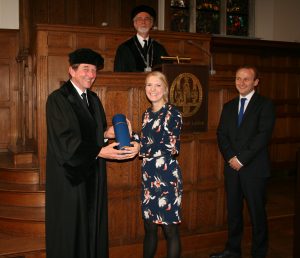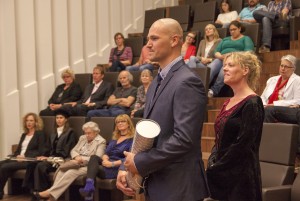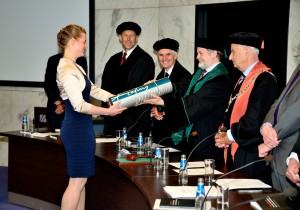Welcome
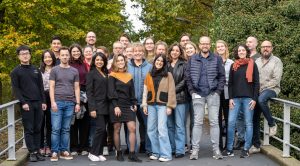 Research in our group, based at the dept. of Molecular Genetics of the Erasmus MC, is focused on elucidating the molecular mechanism and regulation of Nucleotide Excision Repair and its impact on human health. This important DNA repair mechanism protects organisms against DNA damage-induced carcinogenesis and premature aging. In our lab, we apply a multidisciplinary approach to improve our understanding of its molecular mechanism, working from the molecular genetic, biochemical and cell biological level to the level of intact eukaryotic organisms and patients.
Research in our group, based at the dept. of Molecular Genetics of the Erasmus MC, is focused on elucidating the molecular mechanism and regulation of Nucleotide Excision Repair and its impact on human health. This important DNA repair mechanism protects organisms against DNA damage-induced carcinogenesis and premature aging. In our lab, we apply a multidisciplinary approach to improve our understanding of its molecular mechanism, working from the molecular genetic, biochemical and cell biological level to the level of intact eukaryotic organisms and patients.
News
July 2024
- We published a paper in Nature communications in which we identify DDA1 as subunit of the CRL4CSA complex, showing that it coordinates ubiquitination dynamics during TC-NER.
April 2024
- We collaborated on a paper of the Lans lab published in Nature Communications showing that TFIIH stalling in XPF or XPG deficient cells causes cellular dysfunction that can be inhibited by preventing stable binding of TFIIH to DNA damage, through XPA or TTDA depletion.
- We collaborated on a paper of the Marteijn lab published in Nature Cell Biology revealing a novel CSB- and CRL4CSA-dependent transcription-coupled DNA repair pathway that deals with DNA-protein crosslinks.
Dec 2023
- We contributed to a paper in NAR Cancer howing that DDB2 and HMGA2 promote the detection of oxaliplatin-DNA lesions by NER and that the cellular levels of DDB2 are therefore predictive of oxaliplatin survival in colorectal cancer patients.
Nov 2023
- Arjan Theil co-authored a review published in DNA repair describing new insight into the central function of TFIIH in nucleotide excision repair and listing all currently known TFIIH patients with their symptoms.
Oct 2023
- We published a paper in EMBO Molecular Medicine showing that mutations in TTDN1/MPLKIP that cause trichothiodystrophy lead to instability of lariat debranching protein DBR1 and, consequently, splicing defects and impaired keratinocyte differentiation and skin development.
Sept 2023
- We published a paper in DNA repair illustrating the versatile use of knock-in CSB-mClover cells to study TC-NER dynamics and novel CSB interactors.
Aug 2023
- We contributed to a paper of the Lans lab published in Nucleic Acids Research, describing ‘Recovery of Protein Synthesis’ as novel method to indirectly measure TC-NER.
July 2023
- We collaborated with the Lans Lab on a paper published in Nucleic Acids Research, showing that different SWI/SNF complexes control transcription, R-loop resolution and DNA repair at DSBs in transcribed genes.
April 2023
- We co-wrote an article for Rare Revolution Magazine (p34) on ‘Putting the focus on impactful research to advance neurological understanding in xeroderma pigmentosum’.
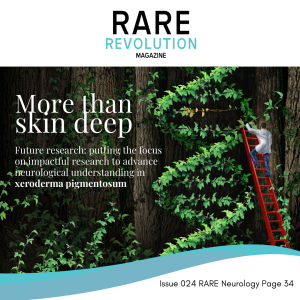
February 2023
- We contributed to a report published in Pediatric Neurology describing a phenotypic resemblance of MORC2-related disorder to Cockayne syndrome.
December 2022
- We contributed to a paper published in Nature showing that RNA-DNA hybrids accumulate in the cytoplasm after R-loop processing and activate an innate immune response.
August 2022
- We contributed to a paper published in Neurogenetics showing that pathogenic mutations in MORC2 cause a Cockayne syndrome-like phenotype.
June 2022
- We contributed to a paper of the Marteijn lab published in Nature Communications, showing that transcription-blocking DNA damage results in the VCP-mediated degradation of promoter-bound Pol II in a GSK3 signaling-dependent manner.
March 2022
- We collaborated on a paper of the Marteijn lab published in Molecular Cell, demonstrating a new role for HLTF in DNA damage eviction during nucleotide excision repair.
- We published a joint review with the Lans lab in Cellular and Molecular Life Sciences describing the function of XPG in nucleotide excision repair and other genome maintenance pathways.
February 2022
- We collaborated on a paper in Nature Communications describing that DDB2 and other NER proteins facilitate repair of oxidative DNA lesions.
- We are part of an expert center for DNA repair disease of Erasmus MC. Amazing Erasmus MC magazine published an article about this expert center (in Dutch).
November 2021
- We collaborated on a paper in Communications Biology describing the role of TFIIH subunit GTF-2H5 in DNA repair and transcription of C. elegans.
June 2021
- We contributed to a paper published in Nature Cell Biology describing the discovery of the new transcription-coupled DNA repair protein ELOF1.
- We are proud and honored to announce that the European Molecular Biology Organization (EMBO) has elected Prof. dr. Wim Vermeulen as a new member. Read more on Amazing Erasmus MC or the EMBO website.
May 2021
- We published a paper in Human Molecular Genetics showing that novel tRNA synthetase mutations in AARS1 and MARS1 redefines trichothiodystrophy as a protein instability in gene expression syndrome.
January 2021
- C2W, the online magazine of the KNCV (Royal Netherlands Chemical Society), published a clear short article (in Dutch) describing the tissue-specific DNA repair activity we recently reported in Cell Reports.
- We published a paper in Cell Reports describing intriguing differences in DNA repair and DNA damage response in different tissues of the model organism C. elegans.
September 2020
- We published a paper in Nature Communications showing that DDB2 dissociation promotes DNA damage handover to XPC-TFIIH.
June 2020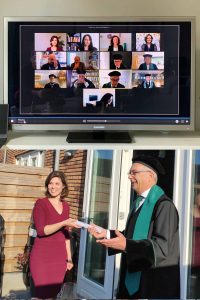
- On 9 June, Cristina Ribeiro-Silva succesfully defended her thesis ‘Nucleotide excision repair through the looking glass’ online.
November 2019
- We collaborated on a paper published in Nucleic Acids Research showing SUMO and ubiquitin-mediated control of transcription-coupled nucleotide excision repair.
October 2019
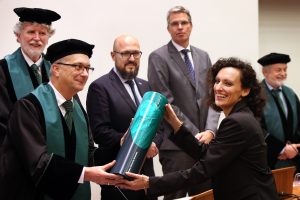
- On 23 October, Mariangela Sabatella succesfully defended her thesis entitled ‘When a cut makes the difference: DNA damage incision from human cells to C. elegans‘.
September 2019
- We collaboratively published a comprehensive review in Nature Reviews Molecular Cell Biology about the DNA damage response to transcription stress
August 2019
- We published a paper in Cellular and Molecular Life Sciences showing that ERCC1-XPF localization to psoralen-DNA crosslinks depends on XPA and FANCD2.
- We published a collaborative paper in American Journal of Human Genetics showing that mutations in the threonyl-tRNA synthetase gene lead to trichothiodytrophy-like features in patients.
May 2019
- We contributed to a paper published in Nucleic Acids Research describing how the stability and subcellular localization of the BER protein Polβ is regulated by its protein interactions.
April 2019
- Melanie van der Woude joined our group as PhD student.
March 2019
- We contributed to a paper published in The EMBO Journal describing extensive SUMOylation and a role for the ACRC/GCNA protease in the cellular response to DNA-protein crosslinks.
- We published a review in DNA Repair on the role of SWI/SNF chromatin remodeling complexes in cancer and DNA repair.
- We collaborated on a paper published in Acta Neuropathologica Communications showing pathological inclusions of the NER protein HR23B in cells of C9ORF72-linked frontotemporal dementia and amyotrophic lateral sclerosis.
- We published a collaborative paper in American Journal of Human Genetics in which we identify mutations in Cysteinyl-tRNA synthetase associated with trichothiodystrophy-like features.
Februari 2019
- We collaborated on a paper published in Nucleic Acids Research on the recruitment of UVSSA to lesion-stalled Pol II mediated by the FACT subunit Spt16.
December 2018
- We collaborated on a paper published in Free Radical Biology and Medicine showing how the anoxia response in developing C. elegans is regulated by neuropeptide signaling.
November 2018
- Alba Muniesa Vargas joined our group as PhD student.
October 2018
- The Dutch television show ‘EenVandaag’ recently broadcasted a short movie on how research on Cockayne syndrome helps to understand and counteract aging (in Dutch).
- Maarten Klunder joined our team as PhD student.
- We published a paper in Nature Communications describing how deficiency of SWI/SNF ATPases BRM and BRG1 sensitizes cells to DNA damage through downregulation of TFIIH subunit p62/GTF2H1.
August 2018
- We published a paper in Nucleic Acids Research describing different repair activities of XPF mutants that cause either XP, FA or XP-CS complex.
- We published a paper in Nucleic Acids Research on the importance of TC-NER and BER in protecting cancer cells against platinum drug induced DNA damage.
- We collaborated on a paper in EMBO reports describing DNA damage and replication stress-induced degradation of acetylated histones by the PA200-proteasome.
- Diana Llerena Schiffmacher started in our lab as PhD student.
June 2018
- We published a paper in Nucleic Acids Research describing transcription-coupled and CSB-dependent recruitment of the BER protein XRCC1 to sites of oxidative DNA damage.
- Irene Salas-Armenteros joined our team as postdoc.
April 2018
- We collaborated on a paper published in PNAS describing differential in vivo dynamics of initiating, promoter-paused and elongating RNA polymerase II.
March 2018
- We published a collaborative paper in Nature Communications describing a role for the TRiC chaperonin in stabilizing CSA protein.
January 2018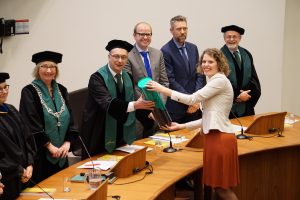
- On 24 Januari, Imke Mandemaker succesfully defended her thesis entitled ‘Unraveling the chromatin in the DNA damage response’.
- We collaborated on a paper describing a new XPF Fanconi Anemia patient.
November 2017
- We collaborated on a paper describing HUWE1-dependent ubiquitylation of histone H1 after UV irradiation.
October, 2017
- We published a paper in Human Molecular Genetics describing how mutations in the GTF2E2/TFIIEβ gene, which cause non-photosensitive trichothiodystrophy, impair transcription and tissue-specific differentiation.
June, 2017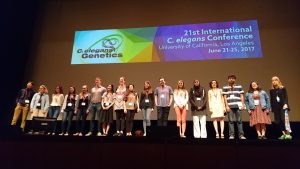
- We contributed to the online Rare Revolution Magazine with an article describing research on Nucleotide Excision Repair disorders in layman’s language
- Mariangela Sabatella won a GSA Poster Award at the 21st International C. elegans Conference in Los Angeles
May, 2017
- We published a chapter in Methods in Molecular Biology describing the use of fluorescence microscopy techniques to evaluate noncanonical ATM activation by transcription-blocking DNA damage
January, 2017
- We published a paper in Nucleic Acids Research describing a new technique to measure TC-NER activity based on amplification of unscheduled DNA synthesis signal
-
- We published a review in Journal of Molecular Biology describing the consequences of DNA damage on RNA polymerase II
- Angela Helfricht obtained her PhD at Leiden University after succesfully defending her thesis entitled ‘Chromatin modifiers in DNA repair and human disease’
July, 2016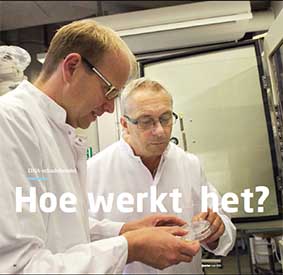
- The 2016 second edition of Erasmus MC Magazine ‘Monitor’ dedicated several articles on research performed in our Molecular Genetics department at Erasmus MC. The interview with Prof. Wim Vermeulen can be read here (in Dutch)
April, 2016
- We co-authored a paper in Nucleic Acids Research on a CSB site-specific ubiquitylation specifically involved in response to oxidative DNA damage
February, 2016
- We published a point-of-view article in RNA Biology discussing a non-canonical ATM-signaling pathway that orchestrates spliceosome organization, alternative splicing and gene expression in response to transcription-blocking DNA lesions
January, 2016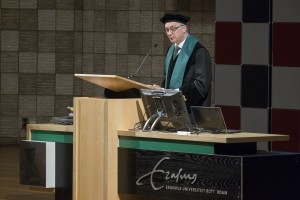
- On January 29, Dr. Wim Vermeulen publicly accepted his appointment as Professor of Genetic Stability with an inaugural lecture entitled ‘Vulnerable Genes’
October, 2015
- We contribruted to a study showing that loss of RAD23 protects against the toxicity of two misfolding-prone proteins causing amyotrophic lateral sclerosis
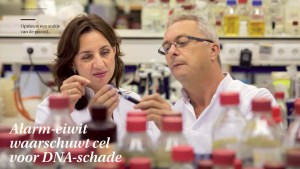
- DNA repair in the spotlight: Nobelprize for Chemistry 2015!! We congratulate laureates Tomas Lindahl, Paul Modrich and Aziz Sancar.
- Erasmus MC Magazine ‘Monitor‘ wrote an article about our recent work on transcription-stalling and ATM activation, which was published in Nature. The Monitor article (in Dutch) can be read here.
- Marit Geijer started in our lab as PhD student
September, 2015
- We published a preview in Molecular Cell discussing a novel tripartite damage checking mechanism in Nucleotide Excision Repair
- Angela Helfricht joined our team as postdoc
July, 2015
- We published a paper in Nature Communications describing that SUMOylated XPC is ubiquitylated by RNF111 to promote its release from DNA damage
June, 2015
- In our new paper published in Nature we show that DNA damage-induced transcription-stalling triggers R-loop formation and ATM activation, which promotes spliceosome dissociation and DNA damage induced alternative splicing
May, 2015
- We published a review describing tissue specific differences in the DNA damage response in C. elegans
April, 2015
- On 17 April, Loes van Cuijk succesfully defended her thesis ‘Ubiquitin-mediated regulation of damage recognition in nucleotide excision repair
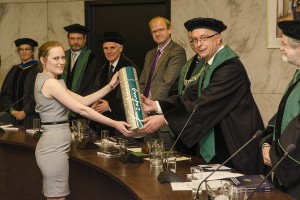 ‘
‘ - Masaki Akita joined us as postdoc
January, 2015
- Alex Pines joined our team as postdoc
October, 2014
- We published a paper on the differential dynamics of RPA during the pre- and po
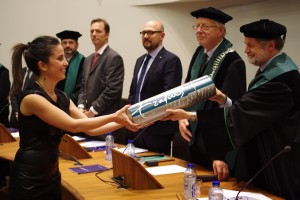 st-incision steps of NER and during replication.
st-incision steps of NER and during replication. - On 29 October, Özge Aydin succesfully defended her thesis entitled ‘Chromatin remodeling in the UV-induced DNA damage response’
- We published a review discussing the various functions of ISWI type chromatin remodeling complexes in the DNA damage response
September, 2014
- Jana Slyskova joined our team as postdoc
July, 2014
- We published a review on the regulation of DNA damage detection in NER by ubiquitin modifications.
- We published a review summarizing recent insights into the function of TTDA, the smallest subunit of the transcription and repair factor TFIIH.
- Our newest research article describes a new function for the SMARCA5/SNF2H chromatin remodeler in fascilitating transcription-coupled NER.
- We published a comprehensive review entitled Understanding nucleotide excision repair and its roles in cancer and ageing.
- On 6 June, Petra Schwertman succesfully defended her thesis entitled ‘Ubiquitination in the UV-induced DNA Damage Response’
- On 4 June, Arjan Theil succesfully defended his thesis entitled ‘Functional Analysis of TTDA: From Human to Mouse – Big impact of a small protein -‘
May, 2014
- Jurgen Marteijn obtained a prestigious Vidi award from the The Netherlands Organisation for Scientific Research (NWO).
- A review was published describing the role of the HIRA, FACT and Dot1L chromatin remodeling factors in transcription restart after DNA damage.
